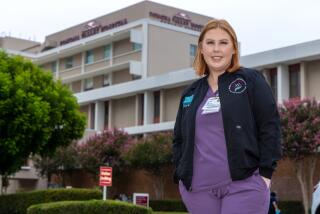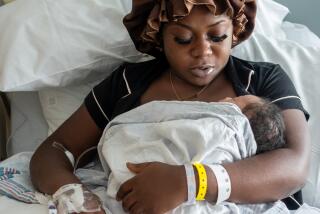Offering their support
- Share via
Several times a day, Jose Ruiz and David Brown stop by Pamela Sumner’s hospital room to check on her. Does she need to be shifted in her bed? Maybe spend a few moments in a chair?
If so, they take their places on either side of her frail torso, carefully put their muscled arms under hers and ease her into a sitting position or out of the bed entirely.
On this warm afternoon, they’ve just taken the 49-year-old freelance writer from West Los Angeles outside. Although she’s been battling a complicated gastrointestinal illness, Sumner is now beaming -- it’s the first time she’s felt the sun’s warmth in three months. “They always have good attitudes,” says Sumner. “If you need it, they’ll do it.”
Ruiz, 35, a former horse trainer, and Brown, 41, a nursing student and competitive bodybuilder, make up one of a half-dozen “lift teams” at St. John’s Health Center in Santa Monica. Assigned to critical care and surgical units, the teams lift patients who need to be moved but who are too weak to raise themselves. They also shift people who are likely to develop bed sores if left in one position for too long.
As helpful as the teams are to patients, it’s the nurses who may be getting the most benefit. Many are plagued by injuries of the back, neck and shoulders from repeatedly lifting, pulling and repositioning patients. An estimated 38% of nurses nationwide suffer back injuries, according to the American Nurses Assn.
“Even a 150-pound patient feels like up to 250 or 300 pounds when you’re pulling them,” says Pat Waldron, a registered nurse who manages St. John’s lift team program.
With the nationwide nursing shortage, Waldron says she can’t afford to lose any of her veteran nurses, most of whom have been at patient bedsides for 20 or 30 years. “We’ve had some nurses who had to leave nursing altogether. I myself had surgery for a neck injury at 24 and was out of work for months,” says Waldron, now 52.
Although St. John’s, like many hospitals, trained its nurses in proper patient movement and the use of devices like sliding boards and special lift chairs, those didn’t make a dent in injuries, Waldron says.
But lift teams in the operating room and critical care units have made a difference. In 2000 and 2001, St. John’s logged 57 lift injuries among staff. Since the lift team program began on July 1, 2002, there have been no new lift injuries, Waldron says.
The St. John’s program, the only full-time lift team program in Los Angeles and Orange counties, was modeled on successes at the University of Washington Medical Center in Seattle and San Francisco General Hospital. Lift teams there were shown to decrease both nursing injuries and lost work days.
Nurses on the St. John’s medical-surgical and intensive care units have come to rely on the lifters. Some are adamant that they remain. “If they go, I go,” says Nancy Whitley, 44, a critical care nurse.
“Everybody is happy to see us,” says Ruiz, who hails from three generations of horsemen and worked at the Santa Anita and Hollywood Park race tracks before becoming a hospital technician and subsequently volunteering for lift team training.
Brown came to St. John’s from UCLA, where he was a certified nursing assistant and where he handled paperwork for the liver transplant team.
At 6 feet tall and 220 pounds, Brown can bench-press 390 pounds.
Although a lift team must be strong, the right attitude is crucial, hospital officials say. If lifters lack the ability to create a rapport and trust, patients are less likely to ask for help. Both Ruiz and Brown seem to have had no trouble forging such a bond with patients -- they perform about 100 lifts a day, engaging those patients who are feeling up to conversation, sensitive to those who are not.
“Our patients are up 50% more now,” says Laura McVay, a critical care nurse who had back surgery for a ruptured disc two years ago because of the repetitive stress of lifting and moving patients.
As the team made its rounds recently, Dale McDowell of Upland said that although he had been hospitalized elsewhere, St. John’s was the first place where the staff made sure he was getting out of bed as his doctors and nurses had directed.
The 63-year-old retired procurement manager had a tumor in his right hip removed. When he would try to move on his own, he’d feel burning pain. He learned instead to wait for Ruiz and Brown to swing by because “it’s much nicer when they move me.”






